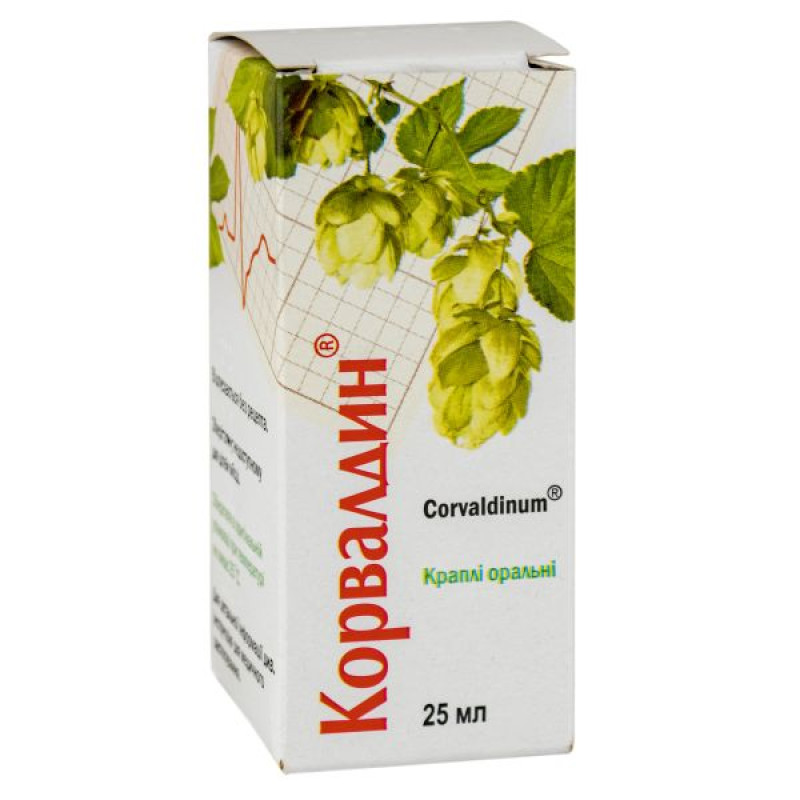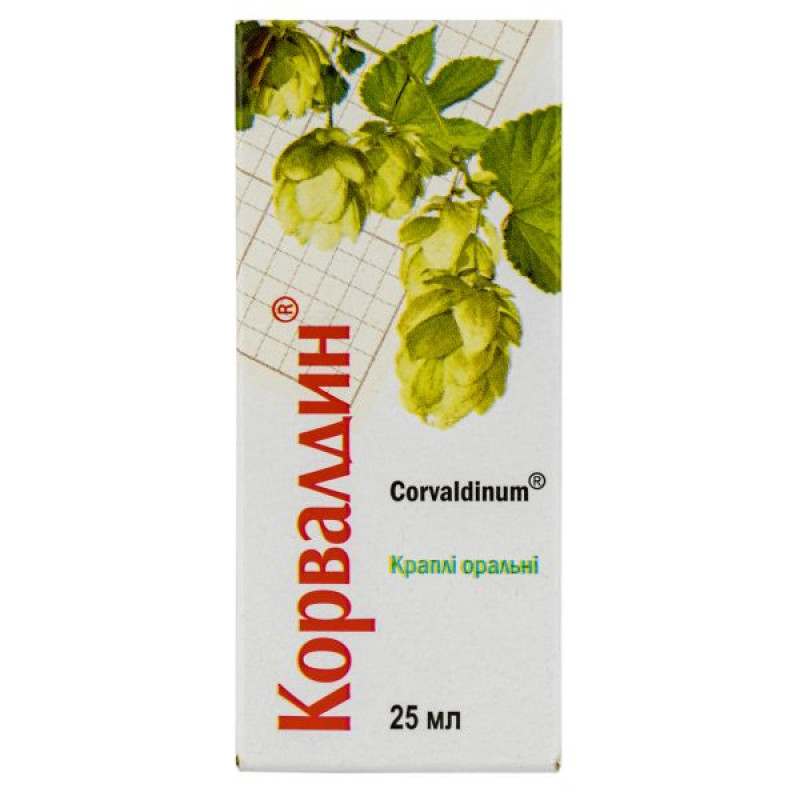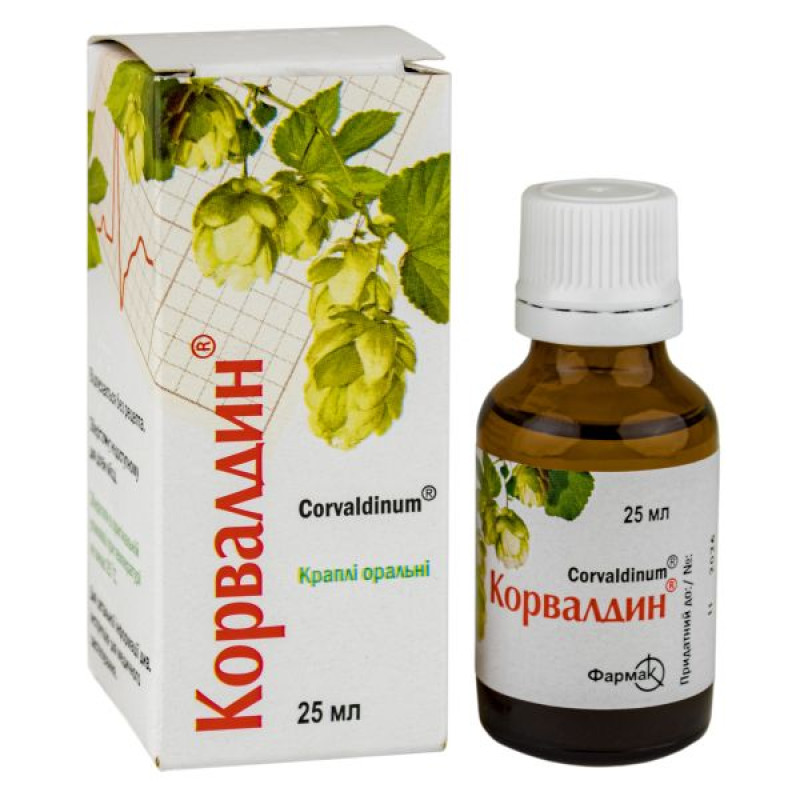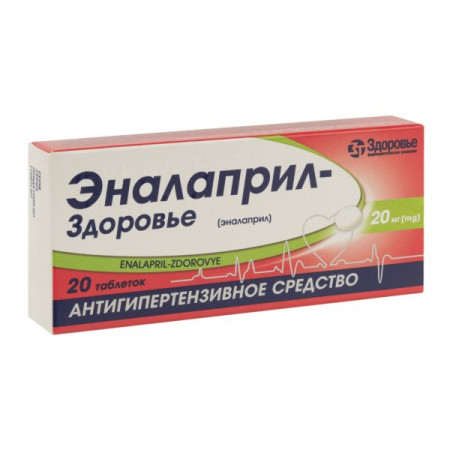Corvaldin oral drops bottle 25 ml

Pharmacological properties
Corvaldin is a sedative and antispasmodic drug, the effect of which is determined by its components.
Ethyl ester of α-bromizovaleric acid produces sedative and antispasmodic effects due to irritation of receptors of the oral cavity and nasopharynx, a decrease in reflex excitability in the central nervous system and increased inhibition in neurons of the cortex and subcortical structures of the brain, as well as a decrease in the activity of vascular centers and a direct local antispasmodic effect on vascular smooth muscle.
Phenobarbital inhibits the excitatory action of the reticular formation centers on the cerebral cortex. Sedative, tranquilizing, and hypnotic effects depend on the dose of the drug.
Peppermint oil and hop oil have a reflex vasodilating and antispasmodic effect, irritating the "cold" receptors of the oral cavity, exhibit a choleretic and antispasmodic effect, and eliminate the manifestations of flatulence.
Ethyl alcohol enhances the effects of each component.
Corvaldin is a sedative that can be used in a state of excitement, fear, nervousness, imbalance and anxiety; has a beneficial effect on the activity of an overloaded and excited heart; is well tolerated by the body if the doses prescribed by the doctor are adhered to. Taking the drug reduces CNS excitation and facilitates the onset of sleep.
Corvaldin lowers overall blood pressure, reduces and prevents vascular spasms, mainly of the vessels of the heart and brain.
Indication
Neuroses with increased irritability; insomnia; in complex therapy for hypertension and vegetative-vascular dystonia; pronounced coronary spasms, tachycardia; intestinal spasms (as an antispasmodic drug).Application
Take 15-30 drops orally before meals with a small amount (30-50 ml) of liquid 2-3 times a day. If necessary, a single dose can be increased to 40-50 drops.
The duration of use of the drug is determined by the doctor depending on the clinical effect and tolerability of the drug.
Contraindication
Hypersensitivity to the components of the drug; severe liver and/or kidney dysfunction; hepatic porphyria; severe heart failure; pregnancy and breastfeeding.Side effects
Corvaldin is usually well tolerated. In some cases, side effects are possible:
from the digestive tract: discomfort in the stomach and intestines, nausea;
from the nervous system: drowsiness, mild dizziness, decreased concentration;
from the immune system: allergic reactions;
Cardiovascular system: slowing of heart rate.
These phenomena are eliminated by reducing the dose.
With prolonged use, dependence on the drug and the phenomenon of bromism may occur. Symptoms: CNS depression, depression, apathy, rhinitis, conjunctivitis, acne, hemorrhagic diathesis, impaired coordination, confusion.
Special instructions
Simultaneous consumption of alcoholic beverages should be avoided.
Long-term use of Corvaldin is not recommended due to the risk of developing drug dependence and possible accumulation of bromine in the body.
The drug should be used with caution in cases of arterial hypotension.
Use during pregnancy and breastfeeding. Do not use during pregnancy and breastfeeding.
The ability to affect the speed of reaction when driving or working with other mechanisms. Contains 62% alcohol by volume, as well as phenobarbital, which can cause impaired coordination and speed of psychomotor reactions, so when taking the drug, you should refrain from driving or working with mechanisms.
Children: There is no experience with the use of the drug in children.
Interactions
Drugs that have a depressing effect on the central nervous system enhance the effect of Corvaldin. The presence of phenobarbital in the drug can induce liver enzymes, so it is undesirable to use it together with drugs that are metabolized in the liver (coumarin derivatives, griseofulvin, glucocorticoids, contraceptives), since their effectiveness will decrease as a result of a higher level of metabolism.
Corvaldin enhances the effect of local anesthetics, analgesics and hypnotics, this is due to the content of barbituric acid derivatives.
When used simultaneously with valproic acid, its effect is enhanced.
When used with methotrexate, its toxicity increases.
Alcohol enhances the effect of the drug and its toxicity.
Overdose
Possible with frequent or prolonged use of the drug, which is associated with the cumulation of its components. Long-term and constant use causes dependence, withdrawal syndrome, psychomotor agitation. Abrupt cessation of the drug may cause withdrawal syndrome.
Symptoms of overdose: CNS depression, confusion, dizziness, ataxia, drowsiness, almost to deep sleep. In severe cases of poisoning - respiratory failure, tachycardia, arrhythmias, decreased blood pressure, collapse, coma.
Treatment: symptomatic.
Storage conditions
In a place protected from light at a temperature not exceeding 25 ° C. Store out of the reach of children.
There are no reviews for this product.
There are no reviews for this product, be the first to leave your review.
No questions about this product, be the first and ask your question.














